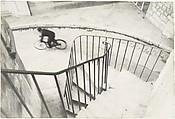Hyères, France
Henri Cartier-Bresson French
Not on view
In 1931 Cartier-Bresson began to use a camera to make photographs that reveal the influence of both Cubism and Surrealism-bold, flat planes, collage-like compositions, and spatial ambiguity-as well as an affinity for society's outcasts and the back alleys where they lived and worked. Within a year, he had mastered the miniature 35mm Leica camera and had begun traveling in Italy, Spain, Morocco, and Mexico, developing what would become one of the hallmarks of twentieth-century photographic style. In his 1952 landmark monograph The Decisive Moment, Cartier-Bresson defined his philosophy: "To me, photography is the simultaneous recognition, in a fraction of a second, of the significance of an event as well as of a precise organization of forms which gave that event its proper expression."
Due to rights restrictions, this image cannot be enlarged, viewed at full screen, or downloaded.

